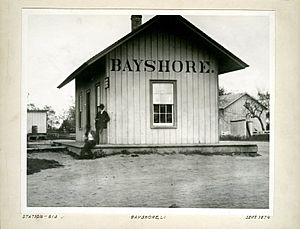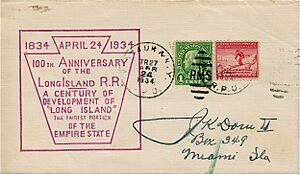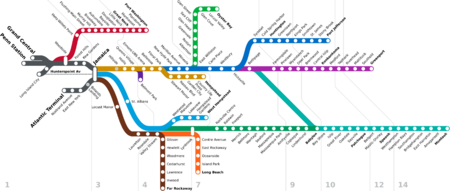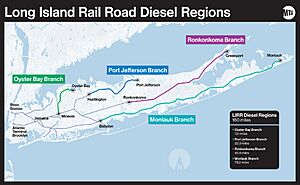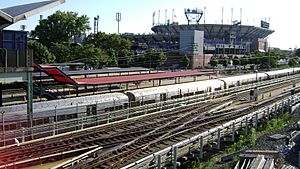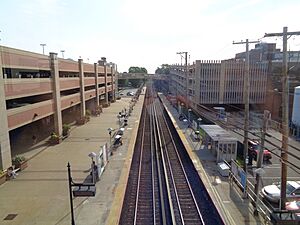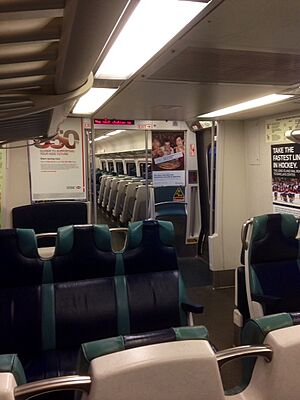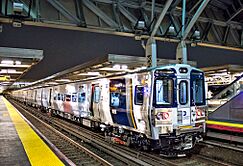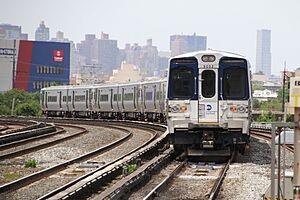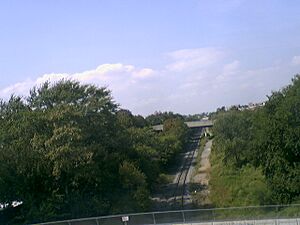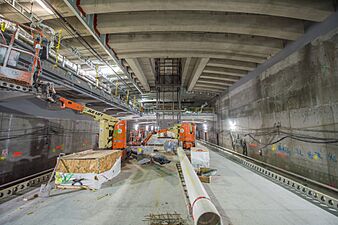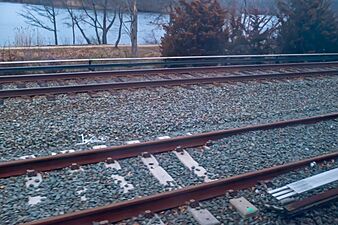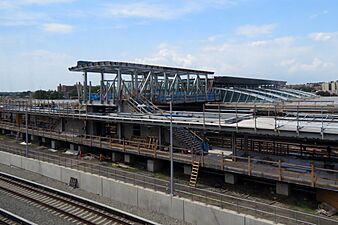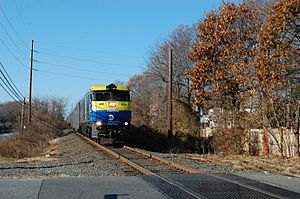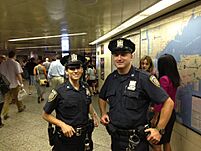Long Island Rail Road facts for kids
Quick facts for kids Long Island Rail Road |
|||
|---|---|---|---|
LIRR sampler electric and diesel services.jpg |
|||
| Info | |||
| Owner | Metropolitan Transportation Authority (MTA) | ||
| Locale | Long Island, New York | ||
| Transit type | Commuter rail | ||
| Number of lines | 11 | ||
| Number of stations | 126 | ||
| Chief executive | Robert Free | ||
| Headquarters | Jamaica station, Jamaica, New York, U.S. | ||
| Operation | |||
| Began operation | 1834 | ||
| Operator(s) | Metropolitan Transportation Authority | ||
| Reporting marks | LI | ||
| Technical | |||
| System length | 319 mi (513 km) (route); 700 mi (1,100 km) (total track length) | ||
| Track gauge | 4 ft 8 1⁄2 in (1,435 mm) standard gauge | ||
| Electrification | 750 V DC | ||
| Top speed | 80 mph (130 km/h) | ||
|
|||
The Long Island Rail Road (LIRR) is a train system in southeastern New York. It stretches from Manhattan to the eastern end of Suffolk County on Long Island. The LIRR mostly carries people who travel to work or school every day. It also moves freight, but a different company handles that.
The LIRR is the busiest commuter train system in North America. In 2016, about 354,800 people rode it on an average weekday. It is also one of the few commuter systems in the world that runs 24 hours a day, every day of the year. The Metropolitan Transportation Authority (MTA) owns the LIRR.
The LIRR logo combines the round MTA logo with the words "Long Island Rail Road." You can see it on the sides of the trains. The LIRR is one of two commuter train systems owned by the MTA. The other is the Metro-North Railroad in the northern parts of New York. The LIRR started in 1834 and has been running ever since. It is the oldest railroad in the United States that still uses its original name.
The system has 126 stations and over 700 miles (1,100 km) of track. Its passenger lines cover 319 miles (513 km) of routes.
Contents
History of the LIRR
The Long Island Rail Road Company started in 1834. Its first goal was to offer daily trips between New York City and Boston. People would take a train to Greenport, New York, then a ferry to Connecticut. From there, they would take another train to Boston.
By 1849, a new land route through Connecticut made this ferry trip unnecessary. So, the LIRR began to focus on serving Long Island. In the 1870s, railroad leaders bought up other small railroads. They combined them all into the LIRR.
For many years, the LIRR did not make much money. In 1900, the Pennsylvania Railroad (PRR) bought a large part of the LIRR. The PRR wanted to build a direct train route into Manhattan. This new route opened in 1910. The wealthy PRR helped the LIRR grow and become more modern. Electric trains started running in 1905.
After World War II, the train business slowed down. The PRR stopped helping the LIRR financially. In 1949, the LIRR faced serious money problems. The State of New York understood how important the railroad was. So, the state began to help the LIRR in the 1950s and 1960s. In 1965, the state bought the LIRR from the PRR for $65 million.
The LIRR was then managed by a new group called the Metropolitan Commuter Transit Authority. This group became the Metropolitan Transportation Authority (MTA) in 1968. With the MTA's help, the LIRR became even more modern. It continued to be the busiest commuter railroad in the United States. The LIRR is one of the few railroads that has kept its original name and purpose since it started.
Main Stations and Terminals
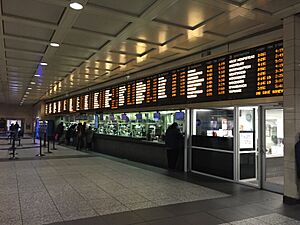
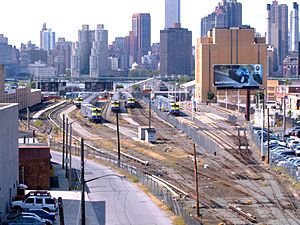
The LIRR uses four main stations in New York City. These are:
- Pennsylvania Station (Penn Station) in Midtown Manhattan is the busiest. Nearly 500 trains use it every day. LIRR trains reach it through tunnels under the East River. You can connect to the New York City Subway, Amtrak, and NJ Transit trains here.
- Grand Central Madison is a new station under Grand Central Terminal. It opened in 2023. This station helps reduce crowding and allows more trains during busy times. It is the main station for the Hempstead Branch. Most electric LIRR trains can use it.
- Atlantic Terminal in Downtown Brooklyn serves the West Hempstead Branch. Some trains from the Hempstead and Babylon Branches also use it during busy hours. It is next to a large subway station, making it easy to get to Lower Manhattan.
- Long Island City and Hunterspoint Avenue are two stations in Long Island City, Queens. The Long Island City station is the oldest LIRR terminal in the west. You can connect to the subway and the NYC Ferry from these stations.
Jamaica station in Jamaica, Queens is a very important hub. It has ten tracks and six platforms. Passengers can switch between almost all LIRR lines here. You can also connect to three subway lines, many bus routes, and the AirTrain JFK to JFK Airport. The LIRR's main office is right next to this station.
Train Lines and Services
The Long Island Rail Road has eleven passenger lines. Three of these are main lines:
- The Main Line runs through the middle of the island. It goes between Long Island City and Greenport, passing through Jamaica.
- The Montauk Branch runs along the southern edge of the island. It goes between Long Island City and Montauk, also through Jamaica.
- The Atlantic Branch runs mostly in New York City. It goes between Atlantic Terminal and Valley Stream, via Jamaica.
There are eight smaller branches. Some branches are divided into sections for scheduling. For example, the Montauk Branch is called the Babylon Branch in its electric part. The diesel service beyond Babylon is called Montauk Branch service. All branches except the Port Washington Branch go through Jamaica. The tracks west of Jamaica (except Port Washington) are called the City Terminal Zone.
Current Branches
- The Main Line runs from Long Island City to Greenport. It is electric up to the Ronkonkoma station. Diesel trains run further east.
- The Montauk Branch runs from Long Island City to the Montauk station. It is electric from Jamaica to Babylon. Diesel trains run east of Babylon.
- The electric Atlantic Branch runs from Atlantic Terminal in Downtown Brooklyn to Jamaica. Then it goes southeast. It becomes the Long Beach Branch or the Far Rockaway Branch.
- The electric Port Washington Branch is the only one that does not go to Jamaica. It serves four stations in Nassau County. It includes the Manhasset Viaduct, the highest bridge on the LIRR.
- The Port Jefferson Branch splits from the Main Line. It has electric service to Huntington and diesel service to Port Jefferson.
- The electric Hempstead Branch splits from the Main Line and runs to Hempstead.
- The electric West Hempstead Branch splits from the Montauk Branch and runs to West Hempstead.
- The Oyster Bay Branch splits from the Main Line. The first part is electric, but most of the line to Oyster Bay uses diesel trains.
- The diesel-only Central Branch connects the Main Line and Montauk Branch. It offers another way to reach the Montauk Branch east of Babylon.
- The electric Far Rockaway Branch splits from the Atlantic Branch and runs to Far Rockaway.
- The electric Long Beach Branch starts where the Atlantic Branch ends. It runs south to Long Beach.
Special Services
The LIRR offers special services in addition to daily commuter trains:
- In summer, extra trains run to Long Island beaches. You can get special tickets for places like Long Beach, Jones Beach, the Hamptons, and Montauk. Some tickets include bus or ferry rides.
- The LIRR runs extra trains to Atlantic Terminal for Brooklyn Nets basketball games at Barclays Center.
- From May to October, four daily trains go to Belmont Park for horse races. On the day of the Belmont Stakes race, even more trains run.
Connections to Other Transit
At Penn Station, you can connect to Amtrak trains and NJ Transit commuter trains. You can also connect to the PATH train, New York City Subway, and New York City Bus systems. Grand Central offers connections to Metro-North Railroad, subway, and bus systems.
Many stations in Brooklyn and Queens connect to the New York City Bus system. Several also connect to subway stations. In Nassau and Suffolk counties, you can transfer to Nassau Inter-County Express and Suffolk County Transit buses.
How to Pay for Your Ride
Like Metro-North Railroad and NJ Transit, the LIRR charges fares based on how far you travel. This is different from the New York City Subway, which charges a flat rate. The LIRR system is divided into eight fare zones.
Zone 1, the City Terminal Zone, includes Penn Station, Grand Central, and all stations in Brooklyn and western Queens. Zone 3 includes Jamaica and other stations in eastern Queens. Zones 4 and 7 cover stations in Nassau County. Zones 9, 10, 12, and 14 cover stations in Suffolk County. The fare is the same for any trip between stations in the same two zones.
Peak and Off-Peak Fares
Peak fares are charged during busy times on weekdays. This is for trains arriving at western terminals between 6 AM and 10 AM. It is also for trains leaving western terminals between 4 PM and 8 PM. If you have an off-peak ticket but ride a peak train, you pay an extra fee.
You can buy tickets from agents or machines. You can also buy them on the train from conductors, but there is an extra fee. This fee is waived if the station has no ticket office or machine. It is also waived for senior citizens, people with disabilities, or Medicare customers.
There are different types of tickets: one-way, round trip, peak, and off-peak. There are also special rates for seniors, people with disabilities, and children. Children can ride for a very low price with an adult on off-peak trains.
Many commuters buy weekly or monthly passes. Monthly passes let you ride any train, any time, within your chosen fare zones.
CityTicket
In 2003, the LIRR started a special program called CityTicket. It allows passengers traveling within New York City to buy one-way tickets for a lower price. This special fare was first available only on Saturdays and Sundays. In 2022, it was expanded to include all off-peak trains during the week for $5. The MTA plans to allow CityTickets on peak trains too, costing $7 each.
CityTicket is valid for travel within zones 1 and 3 on the LIRR. You must buy CityTickets before you board the train. They can only be used on the day you buy them.
| Zone 1 | Zone 3 |
|---|---|
| Penn Station | Jamaica |
| Grand Central | Hollis |
| Woodside | Queens Village |
| Forest Hills | St. Albans |
| Kew Gardens | Locust Manor |
| Atlantic Terminal | Laurelton |
| Nostrand Avenue | Rosedale |
| East New York | Flushing-Main Street |
| Long Island City | Murray Hill |
| Hunterspoint Avenue | Broadway |
| Mets-Willets Point | Auburndale |
| Bayside | |
| Douglaston | |
| Little Neck |
Freedom Ticket and OMNY
The MTA has also explored other ticket options. The "Freedom Ticket" would allow LIRR, bus, and subway service to use one ticket. It would offer free transfers between the LIRR, buses, and subway.
In 2017, the MTA announced that the MetroCard system would be replaced by OMNY. OMNY is a contactless payment system. You can pay with Apple Pay, Google Pay, or special credit/debit cards. The MTA plans to use OMNY on the LIRR and Metro-North Railroad too.
Train Safety and Operations
The LIRR is quite separate from the rest of the national train system. It connects with other railroads in only two places. One is in Sunnyside, Queens, where LIRR trains enter the Amtrak-operated Northeast Corridor. The other is in Glendale, Queens, where the LIRR connects with CSX freight lines.
All LIRR trains have an engineer who drives the train. They also have a conductor who makes sure the train moves safely, collects fares, and helps passengers. Trains may also have assistant conductors. The LIRR still uses some older control towers to manage train traffic. However, many systems are being updated.
Signals and Safety Systems
The LIRR uses different types of signals to guide trains. These include position light, color light, and dwarf signals. Much of the LIRR has an automatic speed control (ASC) system. This system helps engineers keep the train at the correct speed. After a train accident in 2013, the LIRR had to change its ASC system. This led to slightly lower average speeds on the LIRR.
Some parts of the railway do not have automatic signals. In these areas, train movements are controlled by timetables and verbal orders. Many signals and switching systems are being updated as part of the Main Line's Third Track Project.
Power for Electric Trains
The LIRR's electric lines get their power from a third rail. This third rail carries 750 volts of direct current (DC) electricity.
Types of Trains
Electric Trains
The LIRR's electric trains are called M7 and M3 cars. They are electric multiple units (EMUs). This means each car has its own power and can be driven. They usually run in pairs, meaning one car needs the other to work. Train sets are typically 6 to 12 cars long.
In 2013, the MTA announced new M9 train cars would be bought. These new cars would replace older M3 cars. They would also add more space for passengers after the East Side Access project. The first M9 trains started running in 2019.

Diesel and Dual-Mode Trains
The LIRR also uses 134 C3 bi-level coaches. These are pulled by 24 diesel-electric locomotives (DE30AC) and 20 dual-mode locomotives (DM30AC). Dual-mode trains can run on both electricity and diesel fuel. They are mostly used on lines that are not electrified, like the Port Jefferson and Montauk Branches. The LIRR also has 23 MP15AC locomotives used for work trains and moving cars in the yards.
Famous Trains
For most of its history, the LIRR has served daily commuters. But it also had many named trains. Some of these trains offered first-class seats, special parlor cars, and even full bar service. Most of these special trains stopped running after World War II. However, some names were brought back in the 1950s and 1960s.
Current Named Train
- Cannonball is a special train that runs only on Fridays from May to October. It goes to Montauk and has 12 cars. Two of these are special parlor cars with reserved seats and bar service. It started running from Penn Station in 2013. The name "Cannonball" comes from an older train that ran to Montauk from the 1890s to the 1970s.
Freight Train Service
The LIRR has always had freight service, but it has become less common. In recent years, people have realized the need for better freight train service in New York City and on Long Island. Most goods in these areas are moved by trucks, even though there are many train lines.
There have been ideas for a tunnel under the harbor for freight trains. This would help reduce truck traffic. But building it has faced many challenges.
Since 1997, a company called the New York and Atlantic Railway (NYAR) has handled the LIRR's freight service. NYAR uses its own trains and crews. It uses the LIRR's tracks. Freight service goes to various points on Long Island. In the west, it connects with other major railroads like CSX.
Freight-Only Lines
Some LIRR lines are only used for freight trains:
- The Garden City-Mitchel Field Secondary is a short line used for freight and storage.
- The Bushwick Branch runs west from Maspeth to Bushwick Terminal. It used to carry passengers until 1924.
- The Bay Ridge Branch runs south from Fresh Pond to Bay Ridge. It connects to other freight lines and a rail barge service to New Jersey. This branch also had passenger service until 1924.
Future Plans for Service
East Side Access Project
The East Side Access project built a new LIRR line to Grand Central Terminal. This line uses the lower level of the existing 63rd Street Tunnel. The project added a new eight-track station called Grand Central Madison under Grand Central Terminal. This big project started in 2007 and opened on January 25, 2023. It first offered limited service, then full service began on February 27, 2023.
To prepare for East Side Access, the LIRR also improved other parts of its system. They built a new platform at Jamaica station for trains going to Atlantic Terminal. They also added new storage tracks and expanded train yards. There are also plans for a new station in Sunnyside, Queens, which would be a major hub for all LIRR lines.
Main Line Improvements
In 2012, the LIRR started adding a second track to a part of the Main Line. This section was between Farmingdale and Ronkonkoma stations. This project was finished in 2018. It helps trains run more often and smoothly.
As part of preparing for East Side Access, the LIRR also added a third track to parts of the Main Line. This was between Floral Park and Hicksville stations. They also removed train crossings at street level and rebuilt stations. This third track project finished in 2022.
A new station called Elmont station was built on the Main Line. It is located between the Queens Village and Bellerose stations. This station helps people get to the new UBS Arena in Elmont. It is the first new LIRR station in almost 50 years. The eastbound platform opened in 2021, and the westbound platform opened in 2022.
Electrification Projects
The Central Branch of the LIRR is planned to become electric. This will allow more train options and help when there are service problems.
Many people also want to electrify the rest of the Port Jefferson Branch and the Oyster Bay Branch. Making these lines electric would mean more direct trains to Manhattan. This is because diesel trains are not allowed in Penn Station. Also, dual-mode trains are too big for the tunnel to Grand Central Madison.
Law Enforcement
The Long Island Rail Road Police Department started in 1868. In 1998, it joined with the Metro-North Railroad Police Department. Together, they formed the MTA Police Department.
See also
 In Spanish: Ferrocarril de Long Island para niños
In Spanish: Ferrocarril de Long Island para niños
- List of presidents and trustees of the Long Island Rail Road
- History of the Long Island Rail Road
- List of Long Island Rail Road Stations
- Long Island Rail Road rolling stock
- Palsgraf v. Long Island Rail Road Co.
- 1993 Long Island Rail Road shooting


